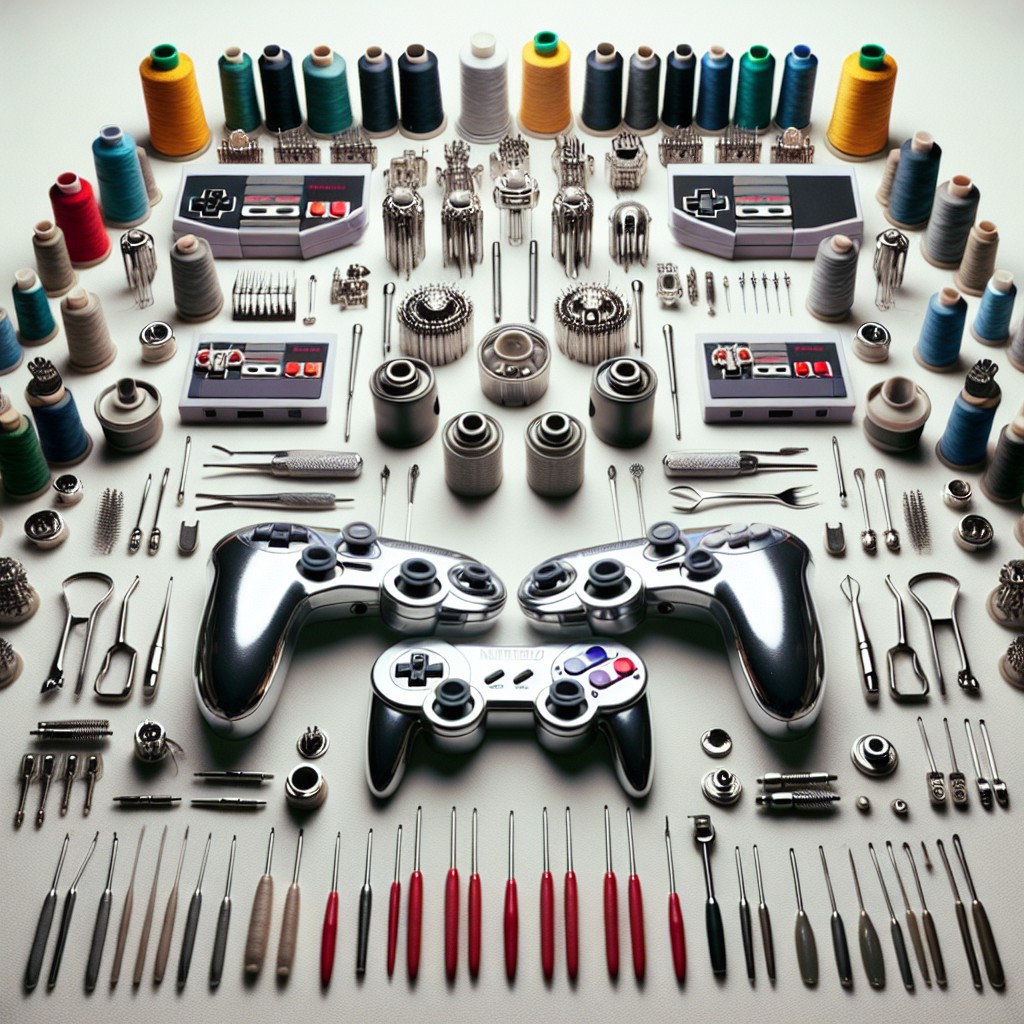Last updated on
Dive into the world of NES thread repair because comprehending its outstanding functionality and supreme quality will revolutionize your understanding of hardware maintenance solutions.
Key takeaways:
- NES thread repair tools are versatile and can address a wide range of thread sizes.
- These tools are efficient, saving time and money in the repair process.
- NES tools have a broad range of applications across industries.
- There are different NES repair kits for internal and external thread repair.
- When selecting a NES tool, consider factors like thread size, material compatibility, and the level of damage.
Table of Contents
Understanding NES Thread Repair Tools

NES thread repair tools are innovative devices designed to restore damaged threads without the need for costly replacements. The tools work by automatically adjusting to the diameter and pitch of the thread to be fixed, simplifying the repair process.
With a versatile range, they can address a multitude of thread sizes, ensuring a broad application scope. Their unique design allows for not only repairing threads but also cleaning them, which can often eliminate the need for a repair outright.
Furthermore, the construction of these tools is robust, crafted from durable materials to withstand the pressures of thread repair. This makes them a valuable asset in both professional settings and home workshops.
They ease the task of restoring threads to their original condition, proving their worth in saving time, money, and resources.
Benefits of Using NES Thread Repair Tools

NES thread repair tools present a practical solution for restoring damaged threads without the need for special training or complex equipment. Their versatility allows them to adapt to a variety of thread sizes and pitches, eliminating the necessity for multiple dedicated repair kits. This adaptability translates into significant cost savings, especially for operations that regularly deal with diverse types of equipment.
Efficiency is another hallmark of these tools, as they reduce repair time by simplifying the process – you can typically fix a thread right on the machine, minimizing downtime. Furthermore, the precision engineered cutting blades ensure a high-quality repair that can often exceed the strength of the original threads, enhancing the longevity and reliability of the equipment.
Environmentally conscious users can appreciate that by extending the life of components, NES thread repair tools also contribute to sustainability efforts, reducing waste and the need for new parts manufacturing. Their ease of use coupled with durable construction means these tools are a sound investment, promising consistent performance over numerous repairs.
The Process of Thread Repair With NES Tools

Repairing damaged threads is made efficient with NES tools through a few clear steps. First, attach the appropriate NES tool to the compromised thread. For external threads, this involves positioning the tool over the thread; for internal threads, you insert the tool into the hole.
Second, rotating the NES tool along the damaged area restores the thread by cutting away imperfections. The unique design of NES blades allows them to adjust to various diameters and pitches without the need for calibration.
Lastly, remove any metal filings left from the repair process using a brush or compressed air. The result is a reconditioned thread that’s ready for use without the need for thread inserts or taps of different sizes.
NES Thread Repair Tools Applications

NES thread repair tools demonstrate their versatility across various industries. In the automotive sector, they are indispensable for restoring damaged threads on engine blocks, spark plug ports, and transmission assemblies. In aviation, these tools help maintain the integrity of critical fasteners on aircraft structures. Machine shops benefit from their ability to quickly troubleshoot and fix threading issues on custom-made components.
The precision instruments are equally essential in plumbing for reviving pipe threads, thereby preventing leaks and maintaining strong connections. In the field of heavy machinery, NES tools play a pivotal role in the maintenance of construction equipment, ensuring that thread damage doesn’t hinder performance or safety. Also, for hobbyists or DIY enthusiasts, these tools offer a practical solution for repairing threads on home appliances or garden tools, ensuring a longer lifespan and proper functioning of the equipment.
Comparing NES Repair Kits: Internal Vs. External Thread Repair
When faced with damaged threads, selecting the appropriate NES repair kit is crucial. Kits designed for internal thread repair are used for fixing threaded holes, such as those in a nut or a tapped hole. These kits typically include tools like thread inserts and a tap that correspond to the internal diameter and pitch of the thread being repaired.
External thread repair kits, on the other hand, focus on repairing the threads on bolts, shafts, or any protruding threaded part. They come equipped with a patented design that allows the tool to adjust to any thread diameter and pitch. This adaptability means one tool can repair a range of sizes, making it both a versatile and cost-effective solution for workshops and individuals handling various equipment.
Internal and external kits differ in the method of application as well. While both require clean and accessible work areas, internal repairs may necessitate the removal of the damaged part from machinery for easier access. External repairs can often be done in situ, especially if the damaged thread is at the end of a shaft or rod.
The underlying principle for both kit types is restoring the thread to a condition where it can securely hold the corresponding bolt or nut, thereby regaining the integrity of the mechanical connection. Each kit is crafted to simplify the process while ensuring a high-quality repair that closely mirrors the strength and alignment of the original threads.
Step-by-Step Guide to Universal External Thread Repair
Begin by cleaning the damaged threads to remove any debris, ensuring the NES tool can grip properly.
Attach the NES external tool onto the damaged thread, adjusting it to fit snugly.
Slowly rotate the tool clockwise; its blades will engage with the good threads.
Continue turning the tool. Its auto-adjusting mechanism will align it with the thread’s pitch and diameter, removing damaged parts as it passes over them.
Once past the damaged section, reverse the rotation to back the tool out, taking care not to apply excessive force.
Check the thread with a nut or bolt appropriate for the thread size to ensure smoothness.
If needed, pass the tool over the thread again to refine the repair.
Clean the repaired thread with a cloth or brush to remove any metal shavings or residues.
Selecting the Right NES Tool for Your Repair Job
Selecting the appropriate NES tool requires an understanding of the job at hand. For threads damaged by wear, rust, or cross-threading, it is crucial to assess the size and type of thread. NES offers tools for a wide range of thread sizes, both metric and imperial.
For repairing internal threads, such as those found in a nut or an engine block, opt for NES internal thread repair tools which are designed to navigate tight spaces. External threads, like on bolts or studs, demand external thread repair tools. These are crafted to fit around the threaded area snugly.
Material compatibility is another factor to consider. NES tools are engineered for use with various metals, ensuring longevity and effectiveness. Check the hardness of the material you are working with to ensure the NES thread repair tool can handle the task.
Lastly, consider the condition of the thread. If it’s severely damaged, you may need a more robust solution from NES’s range. For more superficial fixes, a simpler tool might suffice. It’s about matching the tool not only to the thread size but also to the level of damage and repair required, ensuring a seamless restoration.
Safety Precautions When Using NES Thread Repair Tools
Prior to engaging in thread repair, ensure your workspace is well-organized and adequately lit. The importance of wearing safety goggles cannot be overstated, as they protect your eyes from metal shavings and debris that might become airborne during the repair process. Gloves are also recommended to shield your hands from sharp threads and any cutting fluids or oils that may be used.
It is crucial to use the NES tools as per the manufacturer’s guidelines. Apply steady pressure without forcing the tool, as this may compromise the thread integrity or cause the tool to slip, potentially causing injury. Moreover, keep your fingers clear of the area where the tool is applied to prevent pinching.
Always inspect tools before use for any signs of wear or damage. A compromised tool can lead to suboptimal results and is more likely to break or malfunction during operation. After completing repairs, clean the tools thoroughly to prevent rusting or degradation, ensuring their longevity and safety for future use.
Lastly, pay attention to any cutting oils or coolants used during the process. These should be handled with care, following appropriate disposal methods to prevent environmental damage and potential health risks.
Maintenance and Care of NES Thread Repair Tools
To ensure longevity and optimal performance of NES thread repair tools, regular maintenance and proper care are crucial. Dust, metal shavings, and other debris can accumulate and affect the tool’s functionality, so it’s important to clean the tools after each use. Using a soft brush or compressed air can effectively remove particles from the cutting teeth.
Lubrication is also vital to keep the moving parts of the repair tool functioning smoothly. Apply a light machine oil on the adjustment mechanism to maintain ease of use and prevent rust. Storage conditions can impact the tool’s condition over time, so it’s important to store them in a dry environment, ideally within their original cases or a toolbox to ward off moisture and prevent corrosion.
To maintain accuracy and precision, check the calibration periodically. If the tool becomes dull or damaged, the thread repair may not be as effective. Replace cutter wheels and blades as necessary to maintain the sharpness required for repairing threads.
Lastly, handle the tools with care to avoid dropping or jostling them, which can cause misalignment or damage. By implementing these care instructions, you can ensure that your NES thread repair kit remains a reliable resource for many repairs to come.
Where to Purchase NES Thread Repair Tools
NES thread repair tools are available through a variety of channels to cater to different customer needs. For professional users, industrial supply stores, both online and physical locations, often carry these precision tools. Specialists and those seeking expert advice may prefer dealing with local distributors, where staff can provide personalized recommendations based on specific repair jobs.
Online marketplaces like Amazon or eBay are convenient for quick purchases with the added benefit of customer reviews to gauge the product’s performance in real-world scenarios. Additionally, the official NES website may offer the full range of products, direct customer support, and potentially exclusive deals or discounts.
For those who prioritize hands-on buying experiences, hardware stores can be a reliable source, although the selection may be limited compared to specialized suppliers. Depending on geographic location, some may find that regional tool shops and automotive parts retailers stock these niche items and offer the advantage of immediate availability without shipping concerns.




